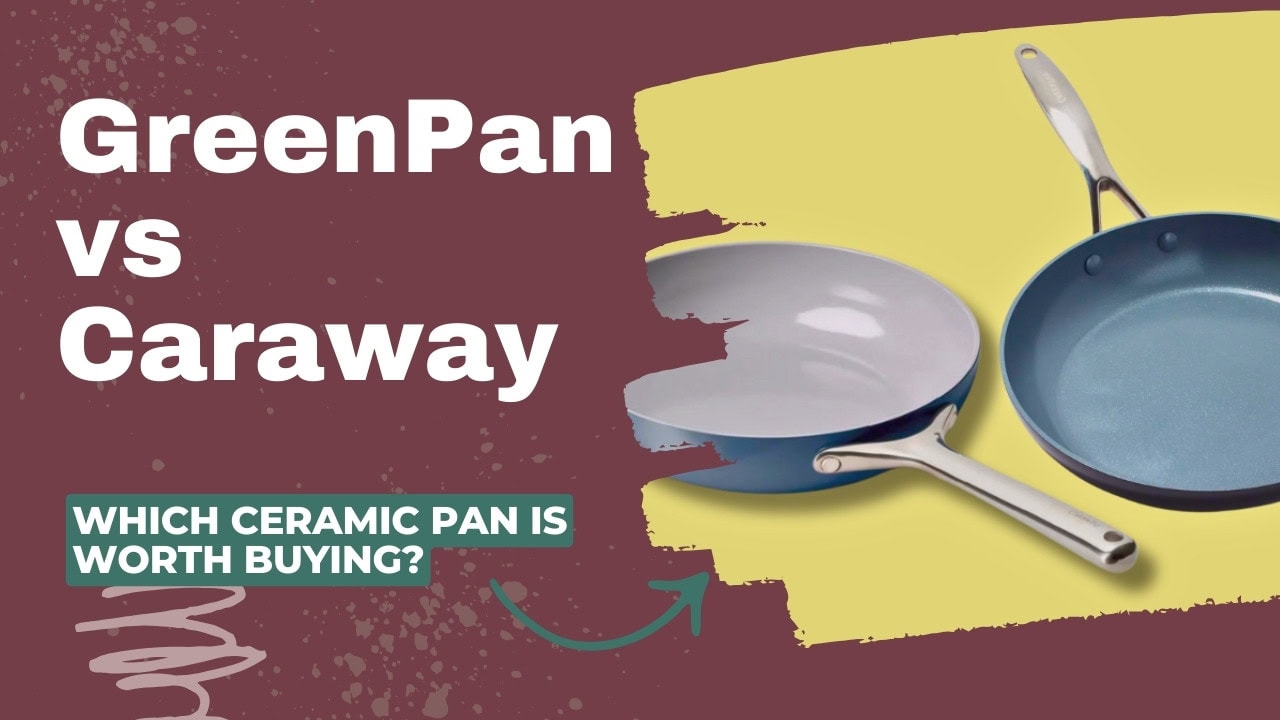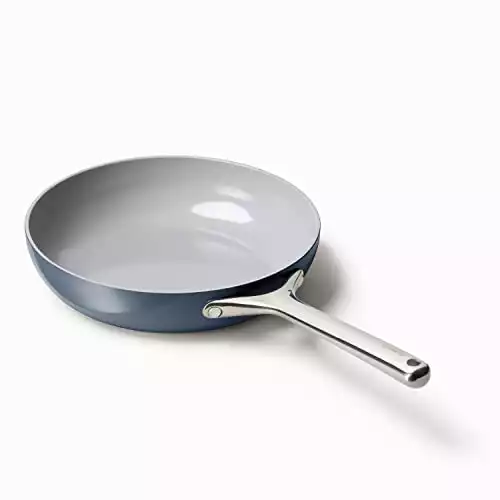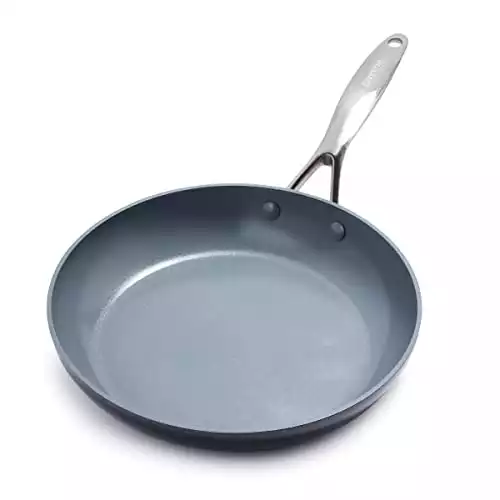It’s hard to choose a winner between the Caraway fry pan and the GreenPan Valencia Pro. These two pans are extremely similar, down to the sparkly gray sol-gel ceramic coating.
I’ve tested both. Caraway’s deeper shape makes it more like a do-it-all pan, but the GreenPan Valencia Pro is one of the best ceramic fry pans on the market.
The Winner
Caraway Fry Pan vs. GreenPan Valencia Pro
Caraway
Our rating:
78/100
Core material:
4mm aluminum
Coating:
Proprietary
ceramic
Weight:
2.8 pounds
Rim-to-Rim Diameter:
10.25”
Cooking Surface Diameter:
8”
Handle:
Stainless steel
Oven Safe?
550°F (287°C)
Dishwasher?
Not recommended
Origin:
China 🇨🇳
GreenPan Valencia
Our rating:
75/100
Core material:
aluminum
Coating:
Thermolon ceramic
with diamond dust
Weight:
2.24 pounds
Rim-to-Rim Diameter:
11”
Cooking Surface Diameter:
9”
Handle:
Stainless steel
Oven Safe?
600°F (315°C)
Dishwasher?
Not recommended
Origin:
China 🇨🇳
About This Review
In this review, I’m going to share my experience testing a 10.5”(10.25" actual diameter) Caraway fry pan vs. a GreenPan Valencia fry pan.
Although Caraway only makes one line of ceramic cookware, GreenPan makes several – from budget pieces to high-end competitors. The Valencia Pro is the GreenPan line most similar to Caraway in price and quality, so I’m going to focus on it in this review. But I’ll share some helpful information on other GreenPan products along the way.
Key Differences Between Caraway and GreenPan Cookware
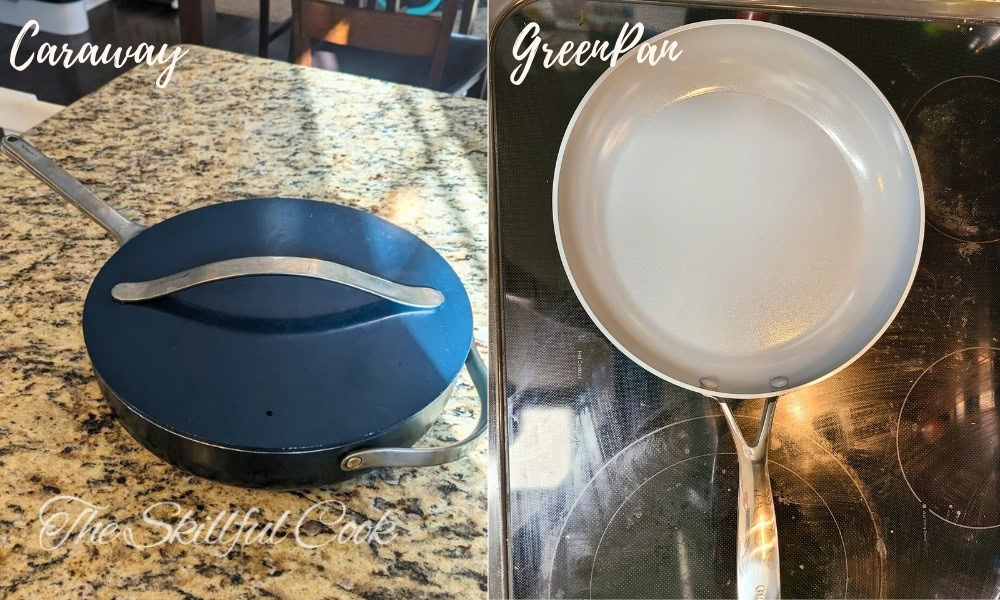
Cooking Performance
Caraway and GreenPan are both ceramic-coated pans. They are nonstick compared to bare metal like stainless steel, but they’re never going to be as slick as a Teflon pan. If you’re used to traditional nonstick, you’ll need to adjust your expectations when cooking in these pans.
In a new, good-quality Teflon pan, you should be able to fry an egg without oil and watch it slide off the pan without leaving a trace. In my experience, that doesn’t work with ceramic pans. Both GreenPan and Caraway suggest you can use “less oil” in their skillets, but recommend using a small amount of fat or oil for optimal cooking.
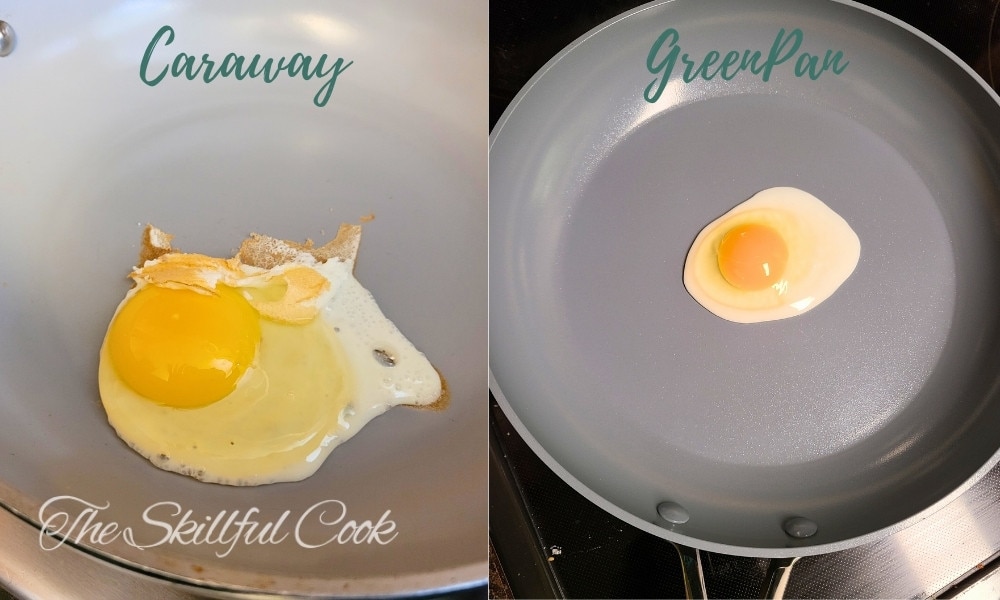
The 10.25” Caraway pan is almost a pound heavier than the 11” GreenPan skillet, even though it’s a smaller pan. It has a thick 4mm aluminum body with a stainless steel induction plate in the bottom. The GreenPan is only about 2.5mm thick; although it has a sturdy induction-friendly base as well. GreenPan Valencia Pro is made of hard anodized aluminum; meaning the metal has gone through an electrochemical process to make it harder and more warp-resistant.
The GreenPan is more responsive; it heats up faster, but it also loses that heat faster. Two cups of water came to a boil faster in the Caraway pan, thanks to its great heat retention. The Caraway pan also heated extremely evenly, unlike GreenPan.
I found the Caraway pan to need a higher burner setting to fry eggs or brown pancakes; while the GreenPan worked better on low to moderate heat.
The GreenPan worked better on an induction burner. The heavy Caraway pan, despite its stainless steel base, struggled to come up to temperature on induction.
So Which Pan Cooked Better Food?
Compared to cheaper ceramic alternatives like GreenLife or BlueDiamond, Caraway and GreenPan Valencia Pro both performed very well. They heated more evenly and produced much better results, especially when I used a spoonful of oil. Eggs, pancakes, and seared chicken breast all turned out tasty on these two pans.
Overall, on my gas stove, I liked working with Caraway better than GreenPan. But not everyone agrees with me. The professionals at America’s Test Kitchen put several top ceramic cookware brands through rigorous testing, and the GreenPan Valencia Pro was their winner. Caraway didn’t make the final round.
Build Quality
Both the Caraway pan and GreenPan Valencia pro have long stainless steel handles attached with two rivets. The rivets tend to collect browned and gummy oil. The handle of the Caraway pan is rounded and more comfortable to hold than the GreenPan, but I liked the angle of the GreenPan handle better. Both handles got hot on my gas stove but stayed cool enough on an electric burner.
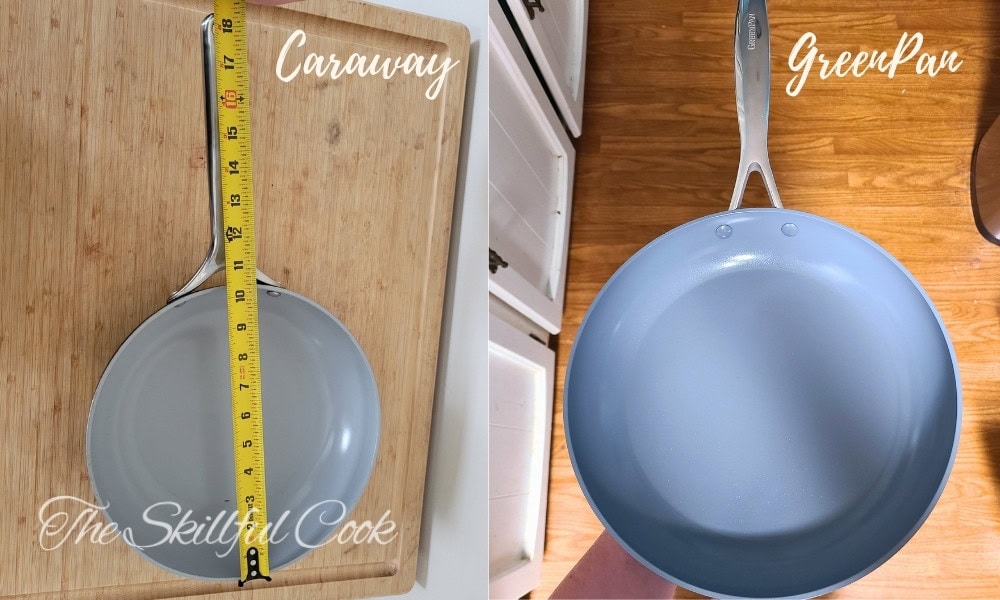
Both pans have a gray sol-gel ceramic coating with a lightly textured sparkly finish. We aren’t told what minerals make the Caraway pans sparkle, but GreenPan uses diamond dust. The diamond dust probably adds more marketing value than actual protection to the coating. But whether or not the diamond dust is responsible, the coating on the GreenPan Valencia Pro resists scratches better than the coating on cheaper GreenPans I’ve used, such as the Rio.
Both the Caraway fry pan and GreenPan Valencia Pro have solid, thick bases that sit flat on the stove and resist warping.
Where is GreenPan Made?
GreenPan products are made in China, in factories owned and operated by the brand’s parent company, The Cookware Company. The Thermolon sol-gel coating is made in South Korea. The Cookware Company owns four factories in different countries, but the GreenPan products are all manufactured in China.
Design and Comfort
The Caraway pan wins the beauty pageant. It’s uniquely designed, with gentle curves and elegant lines. The pan lids have arched handles instead of the typical knob. Caraway pans come in a variety of bright, nature-inspired colors.
GreenPan Valencia looks like it means business. It’s gray all over; not decorative, but not unattractive. Many users are disappointed when their Caraway pans stain after a few uses; so at least you won’t have to worry about that with GreenPan!
The less expensive GreenPan products, like the Rio line, come in more colors with padded handles.
Versatility
Caraway fry pans are more bowl-shaped than most, with 2.5” sides. This makes it great for boiling or reheating large amounts of food. But the pan’s depth and high sides make flipping food a little tricky.
The GreenPan fry pan is an ideal size and shape for a skillet, in my opinion. It’s easy to slip a spatula under eggs or crepes in this pan.
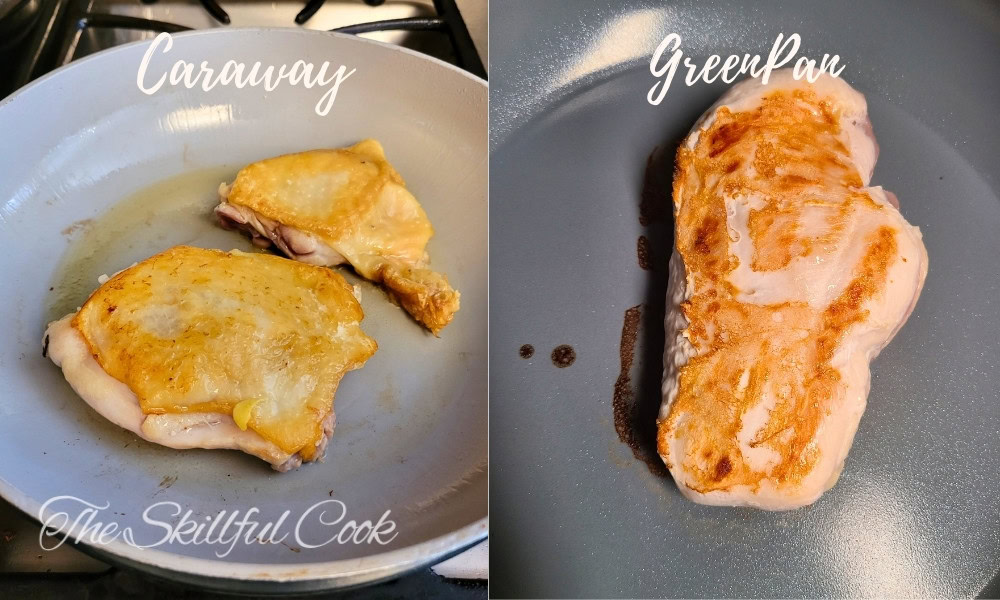
Both Caraway and GreenPan Valencia Pro pans are oven-safe to 550°F or more. (This is not the case for other models of GreenPans, so check your specific pan!) So you could use either of these pans for a one-pot, stove-to-oven meal. Just be careful! The stainless steel handles will get very hot in the oven! The GreenPan lids are oven-safe up to 425°F.
Unlike many aluminum pans, both Caraway and GreenPan Valencia Pro have a ferritic metal base that makes them work on an induction stove. In my experience, though, as I mentioned above, GreenPan heats up better on induction than Caraway.
Beyond skillets, the GreenPan Valencia Pro collection includes a variety of pots and pans. You get saucepans, fry pans of various sizes, a griddle, and a saute pan in the full GreenPan Valencia Pro cookware set.
Caraway regularly adds new products. Currently, the brand offers a fry pan, saute pan, stock pot, and saucepan in its ceramic cookware set. Caraway also sells bakeware and food storage solutions.
Ease of Use and Maintenance
GreenPan markets the Valencia Pro collection as being dishwasher safe. But if you’ve ever used ceramic-coated pans before, you’ll know how quickly the dishwasher wreaks havoc on the coating. Both GreenPan and Caraway should be hand-washed for best results. And, thankfully, hand washing these pans is extremely easy.
The biggest issue you may run into is browned, gummy oil collecting on the edges of the pan. If your pan is relatively new but starts to stick, you may also have an invisible layer of gummy oil on the cooking surface of the pan. Warm water, baking soda, and a magic eraser sponge will take this off and restore your pan. The dishwasher will not help – and scrubbing with abrasive sponges will damage the coating.
This sticky oil is a common issue for both of these pans, since – unlike Teflon nonstick coatings – ceramic conducts heat. (In other words, the nonstick coating itself heats up and can bond with the oil.) Avoid high burner temperatures, cooking sprays, and low smoke-point oils to reduce the problem.
Since the GreenPan is lighter weight for its size than Caraway, it’s easier to handle.
Longevity and Warranty
GreenPan has a slightly better warranty than Caraway – at least on paper. Caraway offers a 1-year warranty on its products, while GreenPan has a 2-year warranty on the coating and a lifetime warranty on the rest of the pan. That said, the GreenPan warranty doesn’t cover “normal wear and tear” – so it’s unlikely they’ll actually replace your pan.
GreenPan has a 60-day return policy – but they’ll only accept returns for unused items in the original packaging. Caraway has a shorter but better return policy; they’ll accept returns for 30 days with few questions asked. So if you want to try a ceramic pan to see if you like it, go with Caraway and test it as soon as you receive it. At worst, you may have to pay for return shipping.
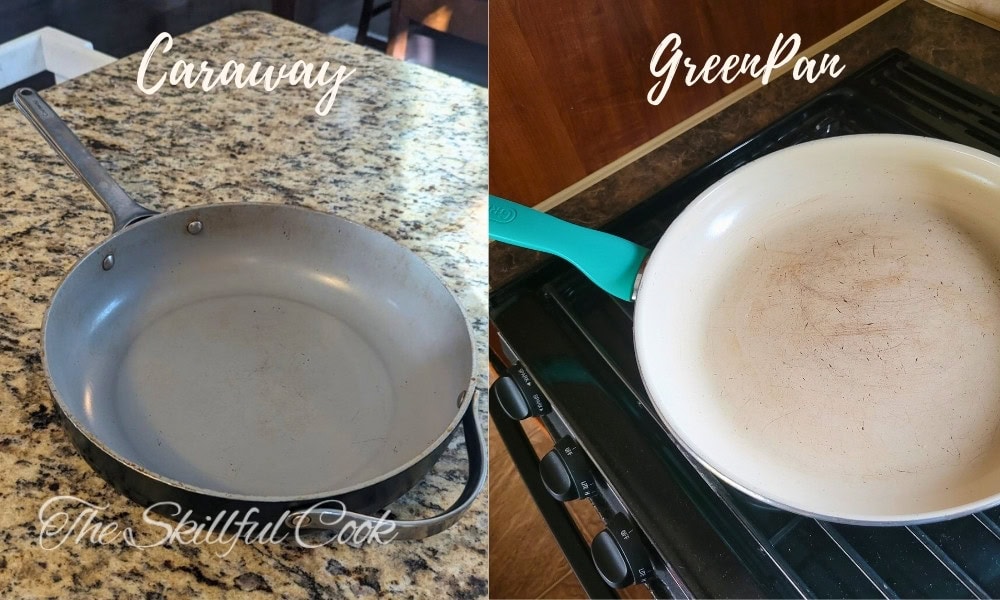
Since both of these pans are built so well, the pan bodies should last a very long time without denting, warping, or having the handles come loose. Don’t expect the coating to last more than two years, though, even if you handle it gently.
I’ve personally used 2-year-old Caraway and GreenPan products. By that time, they have a few scratches, show obvious wear, have very stained undersides, and aren’t very nonstick.
Price and Availability
GreenPan products are easy to find in local retailers if you live in the US. You can find them at Walmart, Meijer, Target, World Market, Crate & Barrel, and many other stores. The selection varies at these retailers – so check online to make sure the store carries the Valencia Pro collection before you make the trip out.
Caraway is harder to find locally. Some Crate & Barrel stores have them; but you’ll probably need to order this brand online. Thankfully, they’re everywhere on the internet – and you’ll almost certainly be getting Caraway ads after reading this article!
Some collections of GreenPan products compete in the budget category. But the Valencia Pro is higher priced. It’s still usually more affordable than Caraway, especially if you buy a whole set. Caraway is one of the highest-priced ceramic cookware brands out there.
Health and Safety
All ceramic-coated cookware is made with a technology called sol-gel. Different companies use different formulas, but they all use a silicone dioxide or similar mineral base, with binders, pigments, adhesives, and possibly additives like diamond dust. This is sprayed onto the metal pan body and cured, resulting in a nonstick surface. GreenPan calls its coating “Thermolon” – but it’s not very different from the coating on Caraway or any other nonstick ceramic pan.
Sol-gel technology is relatively new. In fact, GreenPan pioneered ceramic-coated pans in the mid-2000s. Since there hasn’t been enough time to test the long-term effects of cooking on nonstick ceramic, most experts consider it “likely safe.”
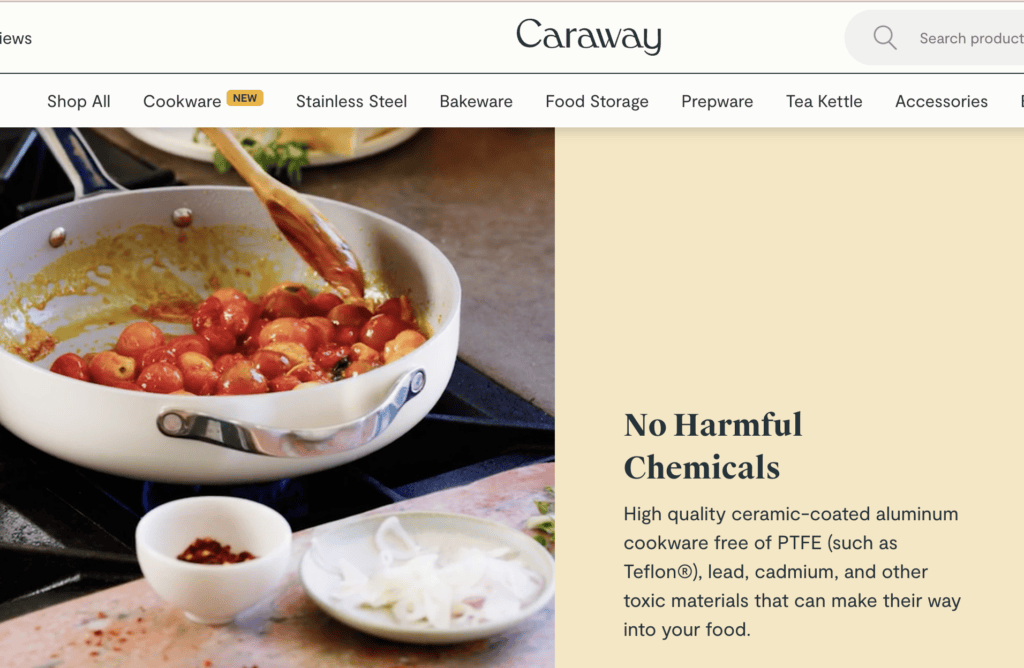
Sol-gel formulas are proprietary, so we don’t know exactly what they contain. We do know that they are made without PTFE (Teflon) or PFAS (“forever chemicals.”) In Caraway’s favor, the company makes public its third-party test results for lead, cadmium, and PFOA.
Thanks to a recent California law called AB1200, it’s easier to find out what chemicals or harmful metals are added to cookware. Check out the AB1200 disclosures from GreenPan and Caraway for details.
Company and Environmental Impact
One thing I like about Caraway is the way the company engages with customers. User reports regarding Caraway’s customer service are relatively good, and the company has an active social media presence.
GreenPan is owned by The Cookware Company from Belgium; a giant corporation that owns similar brands such as Blue Diamond, GreenLife, and Green Chef.
Both brands talk a lot about the safety of their products and how manufacturing ceramic coatings produces less CO2 than Teflon coatings. But I don’t see Caraway making many direct sustainability efforts except recyclable packaging.
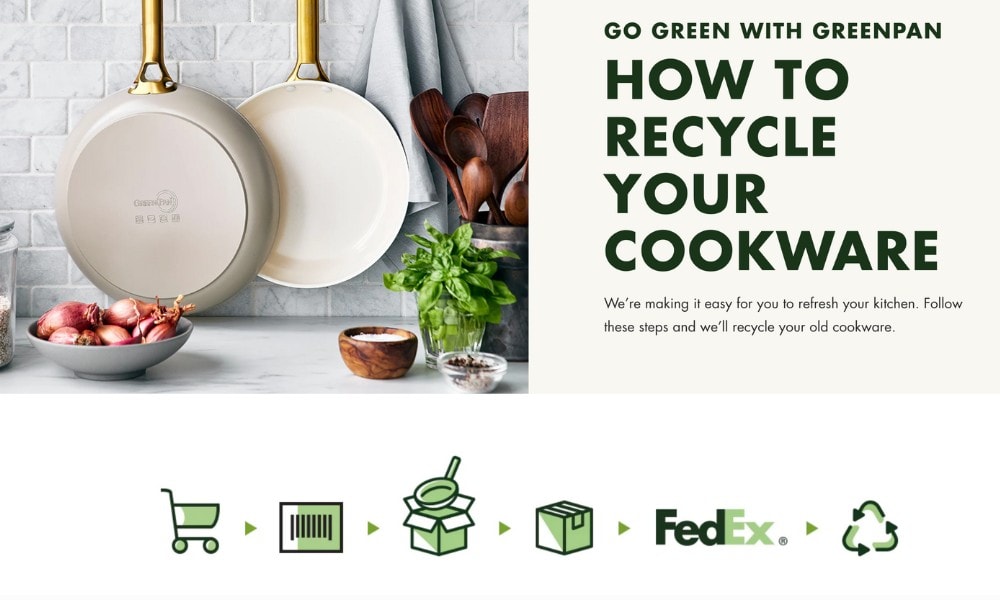
The Cookware Company, the parent company of GreenPan, describes its sustainability initiatives on its website. These include reducing carbon emissions from its Chinese factory and reducing water consumption.
The biggest environmental concern I have is the longevity of these pans. Caraway and GreenPan aren’t likely to last more than 2-3 years before winding up in the landfill. A fully metal pan like carbon steel or stainless steel would be much more eco-friendly.
Is GreenPan a Good Company?
GreenPan is made by The Cookware Company, which has a sketchy reputation. In 2013, the National Advertising Department of the Better Business Bureau asked GreenPan to “discontinue many of the environmental benefit claims it was making for its products.”
There was a class action lawsuit against GreenPan in 2019, which claimed the pans were not “toxin-free” but “contained compounds known to be toxic” including aluminum oxide. The case was dismissed in December 2020 with “no findings of liability” on the part of GreenPan – because the parties reached a settlement agreement.
However, GreenPan still does not make public the exact composition of its Thermolon coating, so some health-conscious consumers avoid it.
Frequently Asked Questions
Do you have to oil Caraway pans?
No, you don’t need to oil Caraway pans – but you should! Caraway pans are more nonstick and will last longer if you use a bit of oil or butter. You don’t need a lot! 1-2 tablespoons of cooking oil or fat is sufficient. Excess oil may burn and stick to the pan.
Do you need to use oil on GreenPan?
You don’t need to use oil on GreenPan products – but you may like the results better if you do. New GreenPan pans should be able to cook light foods like eggs or pancakes without oil or fat. But cooking proteins or vegetables without oil may make them steam and turn mushy instead of fry. As the pan ages, you will need some oil to get a nonstick surface.
Can you use metal utensils on Caraway pans?
Metal utensils should not be used on Caraway pans. The ceramic coating is sensitive to any sort of abrasion. Even if you can’t see the damage, metal utensils will wear the coating down faster. Use silicone or nylon utensils on Caraway pans, and wash them with soft, non-abrasive sponges.
Are Caraway lids oven-safe?
Metal Caraway lids are oven-safe. Glass lids made by Caraway are oven-safe to 425°F, but should not be used with a broiler. Caraway often releases new products, so check the manual for the product you purchase to discover its oven-safe temperature.
Conclusion
So which is better - Caraway or GreenPan? Well, if by “GreenPan” you mean the GreenPan Valencia Pro, you may have a hard choice ahead of you. I liked both of these pans and would consider them the best among ceramic-coated cookware.
In short, Caraway is more expensive, but can hold up to heavy duty if treated gently. GreenPan Valencia Pro has a more typical fry pan shape, is available in more types of pots and pans, and works better on electric or induction cooktops.
Don’t forget that other collections of GreenPan products – like the Rio, Lima, or Paris Pro – may not cook the same way as the Valencia Pro.
What types of GreenPans have you used? Did you like them? Would you consider paying more for Caraway? Let us know your thoughts in the comments!

